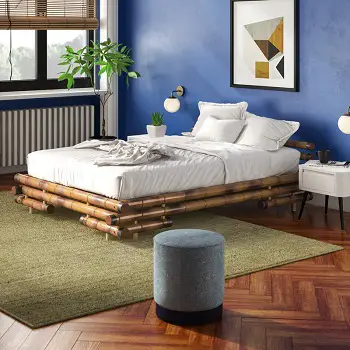There are plants that grow outdoors, and there are those that thrive better indoors. To which group does the bamboo belong? Does it need a lot of sunlight, or is a little sunlight through the windows for a few hours enough for it to grow?
Like most plants, bamboo plants need sunlight as they rely on photosynthesis to grow. Bamboo plants grow both vertically and horizontally, which means that they will need plenty of sunlight to develop and establish themselves where they’re planted.
The amazing thing about bamboo plants is that they chase sunlight when they need to. A tall bamboo plant is one that needs a lot of sunlight as opposed to low but bushy variants of the plant.
When you see a very tall bamboo plant, chances are, the foliage at the bottom is sparse.
On the other hand, if a bamboo plant is not tall, it also happens to have bushy foliage.
This is because bamboo plants tend to grow thicker leaves at lower heights when they receive enough sunlight, while those that are planted in the shade of another tree tend to grow taller so they can get the sunlight that they need and to grow leaves.
How Much Light Does a Bamboo Plant Need?
There are many species of bamboo, and each one needs a specific amount of light to thrive.
For instance, the Sasa, Fargesia, and Thamnocalamus need only a couple of hours of sunlight a day to maximize their growth and thickness of foliage. This is because they are smaller in size compared to their giant cousins, like the Phyllostachys.
The larger bamboo variants, on the other hand, require at least five hours of sunlight a day, and less shade.
With the way bamboos work, the giant ones also have foliage higher up, providing shade for the areas below them.
Why does this happen? Like all plants on Earth, this is because of how photosynthesis works.
What is Photosynthesis?
Simply put, photosynthesis is the process in which a plant converts energy that it uses for growth, and to keep itself alive.
Plants absorb sunlight as fuel, which they use to capture carbon dioxide and hydrogen molecules from the air and soil.
Through oxidation, CO2 and hydrogen are transformed into glucose and oxygen, respectively. Like our bodies, the plants use glucose for energy, while oxygen is released as a waste product that we and other beings on Earth otherwise inhale.
For bamboo plants, the amount of solar energy that they absorb determines how they use the glucose that they have stored through the process.
When the plant determines that it is receiving enough sunlight from the top of the stalk down to the bottom, it turns its focus to growing foliage instead. In this case, the growth of leaves in the bamboo stalks is equal.
You’ll see leaves growing even near the bottom of the plant as well as at the top. As mentioned earlier, this bamboo plant will also be shorter in height because the energy has been diverted to foliage growth instead of height.
On the other hand, if the bamboo plant senses that it needs more energy to produce foliage, it’s going to divert glucose into growing height.
The plant does this so it can find itself in a position where there is enough sunlight to sustain its needs. Only then will it start developing foliage, which will be located higher up.
Can Bamboo Grow in Artificial Light?
Bamboo plants thrive better with sunlight, and a little shade, in the outdoors. They will not thrive indoors and with artificial light.
One plant, however, called the lucky bamboo can thrive indoors with a fluorescent lamp. It’s a small plant and does not need much sunlight as opposed to the bigger bamboo species.
Although called bamboo, the lucky bamboo is not real bamboo but is a dracaena.
Bamboos need lots of natural light from the sun. Depending on their size, however, bamboos can thrive in the shade as long as they enjoy direct sunlight for a certain number of hours during the day.
Planting bamboos have a lot of benefits. However, one needs to know how to properly take care of these in order for them to reap those rewards.
Hopefully, this article about bamboo and its need for sunlight is a step in the right direction.
Bamboo Group is a collaboration of individuals who love the world’s most sustainable and eco-friendly natural material. We believe every home can benefit from the natural colors and patterns of bamboo. We’re excited to see bamboo grow in popularity and get the recognition it deserves. Years of experience growing bamboo plants have taught us a lot we want to share with the world.




